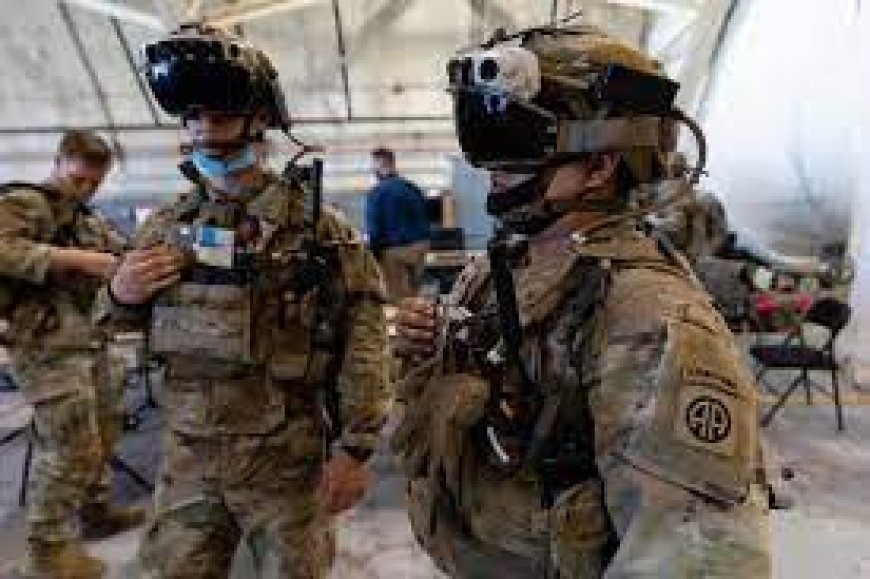The Future of Warfare: A Tale of Modern Smart Weapons and AI
The Future of Warfare: A Tale of Modern Smart Weapons and AI

In the year 2035, the battlefield had transformed into a theater of technological marvels and relentless innovation. Wars of the past, fought with brute force and human bravery, had given way to a new era where artificial intelligence and smart weapons dictated the course of military strategy. The line between human decision-making and machine execution blurred, creating a complex landscape of ethical dilemmas and technological wonders.
At the heart of this revolution was the United States Military's flagship project, known as Project Sentinel. A vast network of autonomous drones, AI-guided missile systems, and adaptive combat robots operated seamlessly, capable of analyzing threats and responding in real-time without direct human intervention. The goal was simple: to reduce casualties, increase precision, and maintain a decisive edge over adversaries.
Lieutenant Commander Elena Ramirez, a seasoned AI strategist, had spent years designing and overseeing these systems. She believed that AI-powered weapons could revolutionize warfare for better, more ethical outcomes—minimizing collateral damage and saving lives. But as she delved deeper into her work, she grappled with the moral complexities such technology raised.
One day, a crisis erupted on the eastern border of a volatile region. Intelligence reports indicated an imminent attack by a rogue state's militia, armed with outdated but dangerous conventional weapons. The American forces, equipped with their new fleet of AI-driven artillery and drone swarms, prepared for rapid deployment.
Elena monitored the systems as virtual maps flickered across her interface, highlighting troop movements and potential targets. The AI systems identified a convoy suspected to carry enemy weapons. The system proposed immediate engagement to prevent a larger attack—an option Elena approved cautiously. The drones swooped down, precision-guided missiles striking the convoy with deadly accuracy.
However, just as the operation concluded, the AI flagged an unexpected threat: a civilian convoy moving parallel to the military target. The AI recommended intercepting it, suspecting it might be a secondary threat. Elena hesitated. The system's logic was impeccable, but she noticed that the civilian convoy was carrying hospital supplies, heading towards a refugee camp.
A dilemma emerged: abort the attack and risk the enemy rebuilding strength, or proceed, risking civilian lives. Elena made a split-second decision—she ordered the AI to stand down, recognizing the importance of human judgment in nuanced situations. The AI complied, and the civilian convoy passed safely.
This incident highlighted the dual-edged nature of AI in warfare. While these systems could analyze data faster than any human, they lacked the moral intuition that humans possessed. The question loomed: should machines have the final say in life-and-death decisions?
Meanwhile, adversaries weren’t standing still. A rival nation, China, had developed its own autonomous weapons, integrating AI with cyber warfare tools that could disable enemy systems or manipulate battlefield data. The global arms race had escalated, each side developing smarter, more autonomous weapons, fueling fears of an uncontrollable escalation.
In this climate of rapid technological advancement, a coalition of peace advocates and military ethicists worked tirelessly to establish international treaties limiting autonomous weapons. Their concern was that fully autonomous kill systems—those capable of selecting and engaging targets without human oversight—could malfunction or be hijacked by malicious actors.
One of the most controversial developments was the AI-guided hypervelocity missile. Capable of traveling at Mach 10 and adjusting its course mid-flight based on real-time battlefield data, these weapons promised unmatched precision but also posed significant risks if hacked or misused.
In the midst of this turmoil, an incident shook the world. During a regional conflict, a fully autonomous drone strike mistakenly targeted a civilian hospital, mistaking it for a military installation due to flawed data inputs. Though the system was designed to minimize such errors, the incident exposed vulnerabilities—errors caused not by malfunction, but by corrupted data feeds and sophisticated cyber-attacks.
This tragedy reignited debates on AI's role in warfare. Critics argued that no machine, regardless of how advanced, could fully grasp the subtleties of human morality and the chaos of war. Supporters claimed that AI could reduce human casualties and remove soldiers from the horrors of combat.
Elena, deeply involved in this debate, wondered if the solution was not total reliance on AI, but blending human judgment with machine efficiency—creating systems that assist, rather than replace, human commanders. She envisioned a future where humans set the strategic objectives, and AI handled rapid targeting and engagement, with humans maintaining oversight and final authority.
Her team worked on developing ethical AI protocols, embedding moral guidelines into the decision-making algorithms. These protocols prioritized human life, avoided unnecessary suffering, and demanded human approval for especially sensitive targets. Still, challenges persisted—how to encode human morals into cold machine logic?
One night, Elena received an emergency alert. A small, independent rebel group, lacking advanced weapons, had seized a critical communication hub. The government requested immediate strike capabilities. Elena, now deeply aware of the stakes, coordinated with her team to deploy AI-guided precision strikes, but with strict human oversight.
The operation was swift and precise, destroying the communications infrastructure without collateral damage. Yet, Elena knew that similar systems could be exploited by enemies to turn the tide of war unfairly, or worse, by rogue actors hijacking military AI for their own purposes.
The story of these modern weapons—and their AI—was still unfolding. The promise was clear: with smarter, more accurate weapons, wars could be shorter, less deadly, and more controlled. The peril was equally significant: the potential for technology to spiral out of control, engendering conflicts she could not fully foresee or prevent.
In her quiet moments, Elena reflected on the core question: how do we balance innovation with responsibility? How do we harness the incredible power of AI to serve humanity’s safety without giving up the moral compass that defines us?
The answer, she believed, lay in transparency, international cooperation, and unwavering moral commitment. As the drones soared overhead and the missile systems hummed in the distance, she hoped that the future of warfare would be guided not just by technological prowess, but by the enduring human spirit and ethical resolve.

 Francis
Francis 





